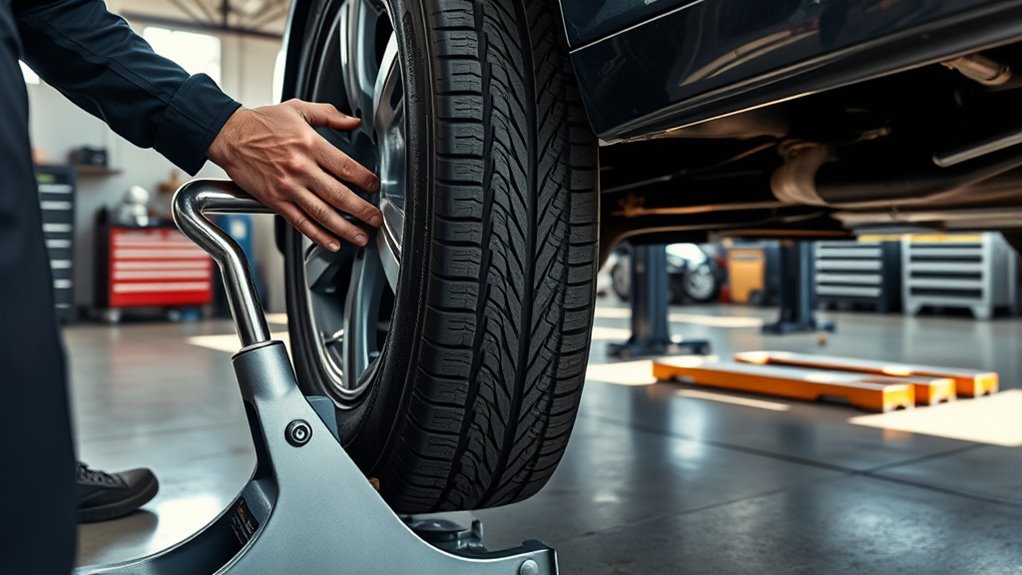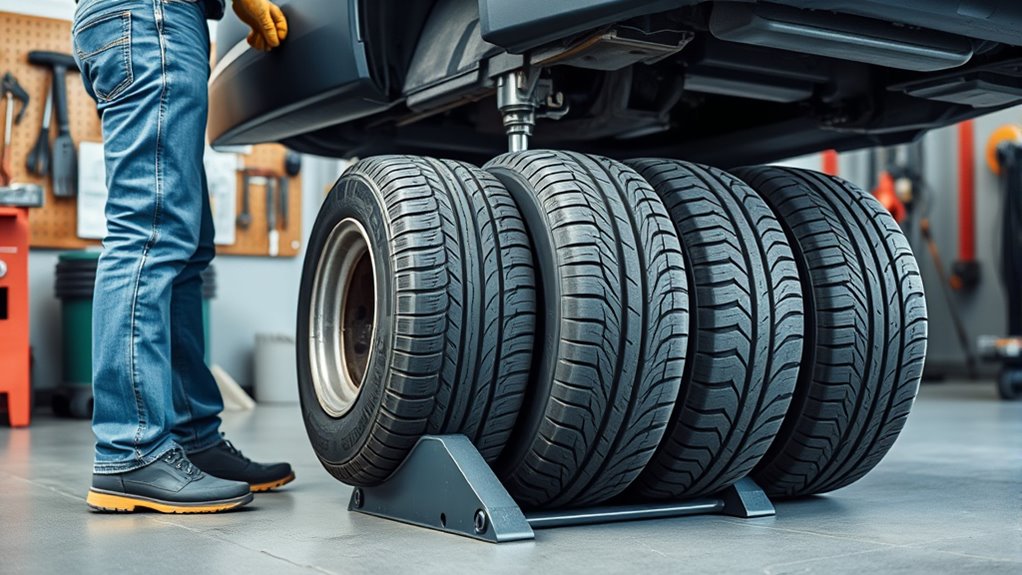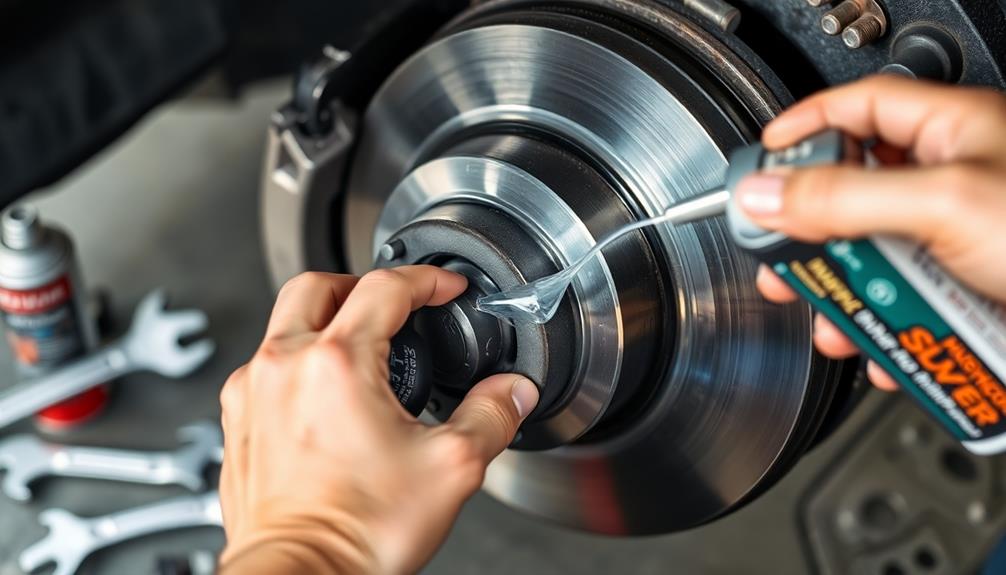To do a tire rotation yourself, first gather necessary tools like a jack, lug wrench, and jack stands. Lift your vehicle safely using manufacturer-recommended points, then slightly loosen the lug nuts before fully removing the tires. Swap the tires according to the recommended pattern, tighten the lug nuts by hand, then lower your car. Use a torque wrench to secure them properly. To get all the details and make certain your tires wear evenly, keep exploring the step-by-step process.
Key Takeaways
- Gather necessary tools, lift the vehicle safely, and remove the tires, noting their original positions.
- Follow the recommended tire rotation pattern, moving tires to new positions accordingly.
- Tighten lug nuts by hand, then lower the vehicle slightly before torque tightening to manufacturer specifications.
- Inspect tires for damage or uneven wear and check tire pressure; balance if needed.
- Reinstall tires, verify proper lug nut torque, and perform a final safety check before driving.

Have you ever wondered if you can rotate your tires yourself to save money and extend their lifespan? Doing your own tire rotation isn’t just cost-effective; it also gives you a better understanding of your vehicle’s health. Before diving in, make sure you have the necessary tools—jack, jack stands, lug wrench, and possibly a torque wrench. Proper tire rotation involves more than just swapping tires; it’s also about ensuring your tires are balanced and your wheel alignment is correct to maximize performance and safety.
Rotating your tires boosts longevity and vehicle health with proper tools and technique.
Start by parking your vehicle on a flat, solid surface and engaging the parking brake. Loosen the lug nuts slightly while the tire is still on the ground to prevent the wheel from spinning. Use the jack to lift your car at the manufacturer’s recommended lift points, then secure it with jack stands. Once the car is securely lifted, remove the lug nuts completely and take off the wheel. As you remove each tire, take note of its position—front left, front right, rear left, rear right—so you can rotate them according to your vehicle’s rotation pattern.
The most common rotation pattern is front-to-back on the same side, with the front tires moving to the rear and the rear tires moving to the front but crossing sides (front left to rear right, and vice versa). After swapping the tires, inspect each one for any signs of damage or uneven wear, which could indicate misalignment or tire balancing issues. Once all tires are repositioned, tighten the lug nuts by hand first, then lower the vehicle so the tires touch the ground but the full weight isn’t on the wheels. Use a torque wrench to tighten the lug nuts to your vehicle’s specified torque to prevent any issues down the line.
But tire rotation isn’t just about moving tires around; it’s also an opportunity to check wheel alignment. Proper wheel alignment ensures your tires wear evenly and your vehicle handles ideally. If you notice uneven wear patterns or your car pulls to one side, it might be time for a professional wheel alignment. Additionally, after completing the tire rotation, it’s wise to check your tire pressure and balance the tires if needed, especially if you feel vibrations while driving. Balancing the tires helps prevent uneven wear and extends the lifespan of your tires. You may also want to consider tire pressure and balance as part of your regular maintenance routine to optimize safety and performance.
Doing your own tire rotation is straightforward once you understand the basic steps. It saves you money, helps you spot issues early, and keeps your vehicle running smoothly. Just remember, if you’re unsure about wheel alignment or tire balancing, it’s best to consult a professional to avoid any safety risks.
Frequently Asked Questions
How Often Should I Rotate My Tires for Optimal Performance?
You should rotate your tires every 5,000 to 8,000 miles for maximum performance. Keep an eye on your tire pressure and tread depth, as uneven wear can signal the need for an earlier rotation. Regularly checking these ensures your tires wear evenly, improving fuel efficiency and safety. Staying consistent with rotations helps extend tire life and maintains proper handling, so make it a routine part of your vehicle maintenance.
Can I Rotate Tires on a Front-Wheel-Drive Vehicle Differently?
Think of your front-wheel-drive vehicle’s tires as dancers on a stage, each wearing different shoes due to tire wear. You can rotate them differently—front to back and cross-patterns—based on specific Tire wear and Rotation patterns. This helps guarantee even wear, prolongs tire life, and maintains ideal handling. Adjust your rotation approach to match your vehicle’s needs, but always follow manufacturer recommendations for best results.
What Tools Are Essential for DIY Tire Rotation?
To perform a DIY tire rotation, you’ll need essential tools like a jack, lug wrench, and a torque wrench. Make sure to check your tire pressure before and after rotation to guarantee peak performance. When tightening lug nuts, use the torque wrench to apply the manufacturer’s specified lug nut torque. These tools help you safely lift your vehicle, properly secure tires, and keep your tires balanced for better driving and longevity.
How Do I Know if My Tires Need Balancing After Rotation?
You’ll know your tires need balancing after rotation if you notice uneven tire wear or vibrations when driving, especially at higher speeds. Pay attention to balancing indicators like a vibrating steering wheel or seat, or uneven tread wear patterns. Regularly check for these signs, and if you experience any, get your tires balanced promptly to guarantee smooth handling and extend tire life after your rotation.
Are There Safety Precautions I Should Follow During Tire Rotation?
Safety is no accident, so always wear proper safety gear like gloves and eye protection during tire rotation. Be aware of hazards such as loose tools or unstable jacks, and keep your workspace clear. Follow proper procedures, use the right equipment, and stay alert to prevent injuries. Remember, a cautious approach guarantees your safety and the job gets done right. Stay vigilant—your safety is worth the effort.
Conclusion
Think of your tires as the heartbeat of your car’s journey. When you rotate them, you’re giving each one a chance to rest and recover, much like tending to a garden’s soil to keep it fertile. By doing this yourself, you’re steering your vehicle’s story with care and confidence. Keep this rhythm steady, and your ride will stay smooth and strong, turning every mile into a well-tended chapter of your driving adventure.









